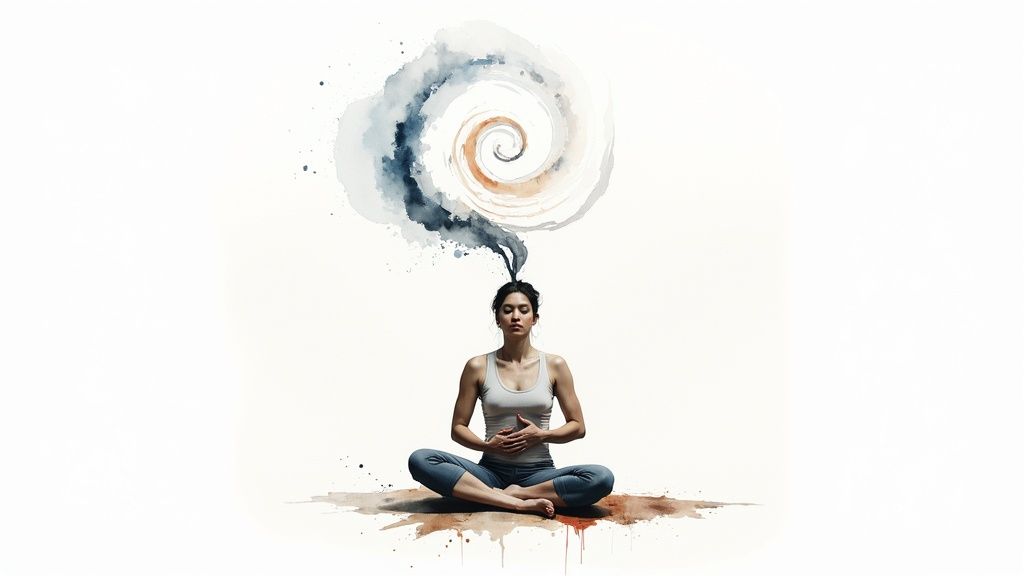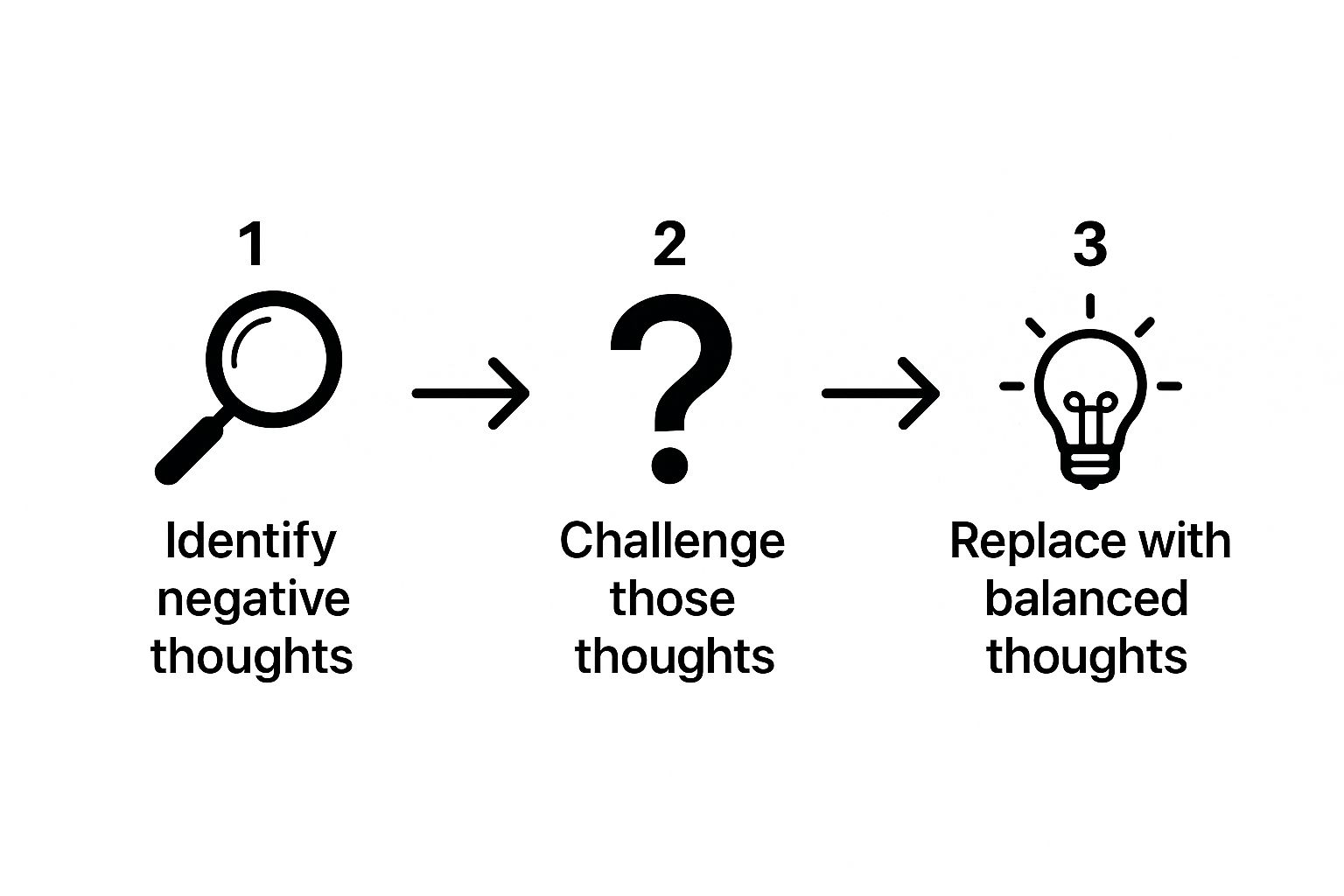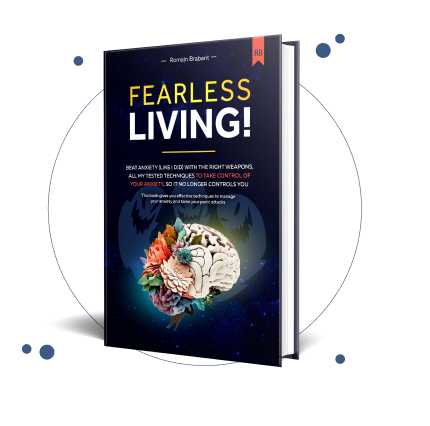
Dealing with anxiety isn’t about flipping a switch and making it disappear forever. It’s about learning how to turn down the volume and realizing you have the power to create lasting change. It means understanding your body’s alarm system, gently challenging the thoughts that send it into overdrive, and building a life that feels grounded, hopeful, and free.
This is a journey of healing, not a search for an overnight cure. By developing practical tools like grounding exercises, cognitive restructuring, and supportive lifestyle habits, you can steadily reduce anxiety’s hold on you. It’s about taking back control and creating a calmer, more intentional life—a life where you feel safe and in command.
Your Path to a Calmer Life Starts Now
If you’re reading this, chances are anxiety has become a heavy, unwelcome companion, and you’re looking for a way to put it down for good. Let’s start with a deep, hopeful breath. A life with less anxiety isn’t just a fantasy—it’s a very real and achievable future for you.
The goal isn’t to eliminate all worry. That’s impossible. Instead, the goal is to fundamentally change your relationship with anxiety so that it no longer controls you.
This is a journey of empowerment. You’ll learn to listen to what your anxiety is trying to tell you, push back against overwhelming thoughts, and build a lifestyle that actively nurtures your peace of mind. Every small step you take is a powerful move toward healing and a life free from panic.
You Are Not Alone on This Journey
It’s easy to feel isolated when you’re in the grip of anxiety, but you are far from alone. Anxiety disorders are actually the most common mental health condition in the world.
In 2019, it was estimated that 301 million people were living with an anxiety disorder. Despite how common it is, a huge treatment gap remains, meaning many people never get the support they need. You can read more about these global mental health trends on SingleCare.com.
By seeking out strategies to feel better, you’re already taking a courageous and powerful step towards a brighter future.
The most important thing to remember is that you can live a panic-free life. It requires learning new skills and perspectives, but healing is absolutely possible. You are capable of regaining control and finding lasting calm.
This guide is your practical roadmap. We’ll walk you through actionable strategies, one by one, to help you feel more in command, starting today.
A Roadmap to Lasting Relief
Trying to tackle anxiety can feel like you’re facing a hundred different problems at once. Instead of getting lost in all the tips and tricks out there, it’s much more effective to focus on a few core pillars that work together to create real, sustainable change.
By mastering strategies in each of these areas, you build a strong, reliable system for managing anxiety from every angle.
Think of the following table as your personal blueprint for healing. It outlines the key approaches we’ll cover, giving you a clear path to building resilience and taking your life back from anxiety’s grip.
Core Pillars of Anxiety Management
| Pillar | What It Means | Why It Helps |
|---|---|---|
| Decoding Signals | Learning to recognize your unique physical and mental anxiety triggers. | Turns anxiety from a mysterious threat into a predictable pattern you can address. |
| In-the-Moment Tools | Using immediate grounding techniques to calm your nervous system during a spike. | Gives you the power to manage panic attacks and acute anxiety as they happen. |
| Thought Reframing | Identifying and challenging negative thought patterns that fuel the anxiety cycle. | Helps you break free from worry loops and develop a more balanced inner voice. |
| Lifestyle Support | Making conscious choices about diet, sleep, and exercise to build mental resilience. | Creates a strong foundation that makes you less vulnerable to daily stressors. |
By focusing your energy on these four areas, you’re not just coping—you’re actively building a sustainable foundation for long-term well-being and a panic-free life. Let’s dive into how you can start putting these pillars into practice.
Decode Your Body’s Anxiety Signals

Before you can effectively manage anxiety, you have to learn to speak its language. How does it actually show up in your body?
That sudden racing heart, the tightness in your chest, or the dizzying spiral of “what if” thoughts—they aren’t random. These are all signals from an ancient, hardwired survival system known as the fight-or-flight response.
This system is your body’s built-in alarm, designed to protect you from real, immediate threats. It pumps your body full of adrenaline and cortisol, prepping you to either confront a danger or run for your life. This is incredibly useful if you’re staring down a predator, but not so helpful when the “threat” is a looming work deadline or a crowded grocery store.
The problem is, modern life constantly triggers this primitive response with non-lethal stressors, leaving you feeling overwhelmed and perpetually on edge. The key is to stop seeing these physical sensations as the enemy and start viewing them as information. They are just your body’s way of saying, “Hey, I think we’re in danger!”—and you can learn how to respond calmly.
From Fear to Information
Learning how to handle anxiety really begins with a hopeful shift in perspective. Instead of being terrified of a rapid pulse or shallow breathing, you can learn to recognize them as your personal anxiety signals. They become predictable data points, not scary surprises.
Think of yourself as a detective investigating your own internal world. What happens right before you feel that knot in your stomach? What thoughts are swirling when your mind starts racing?
By paying close attention, you start to identify your specific triggers and the unique ways anxiety manifests in your body and mind. This simple act of observation is more powerful than it sounds. It creates a little space between you and the feeling, giving you a moment to respond thoughtfully instead of reacting on autopilot.
You can live a full and vibrant life, even with anxiety along for the ride. The goal isn’t to silence it forever but to understand its patterns so you are no longer controlled by them. Healing starts the moment you see these signals as predictable and manageable.
Map Your Personal Anxiety Patterns
Recognizing your anxiety patterns is the first real step toward reclaiming control and building a life where you feel safe and secure. While everyone’s experience is a bit different, the symptoms usually fall into a few common categories. Just becoming aware of your specific mix helps you anticipate and prepare.
Here are some of the most common signals to watch for:
- Physical Sensations: A racing or pounding heart, shortness of breath, trembling, sweating, nausea, or tense muscles.
- Cognitive Patterns: Catastrophizing (instantly jumping to the worst-case scenario), obsessive worrying, difficulty concentrating, or a weird feeling of unreality.
- Emotional Responses: A constant sense of dread, irritability, restlessness, or feeling like you’re always on edge.
Start by just noticing which of these show up most often for you. Simply acknowledging them without judgment—”Ah, there’s that tight chest feeling again”—is a huge first step. It demystifies the experience, transforming it from a powerful, random force into a familiar pattern you can learn to navigate.
This is the foundation for getting your life back.
Powerful Techniques for In-the-Moment Calm

When a wave of anxiety hits, you don’t have time for complex strategies. You need something that works right now to help you find your footing again.
The incredible news is that you have the power to calm your own nervous system, no matter where you are. These aren’t just clever distractions; they are tangible skills that directly counteract your body’s fight-or-flight response, proving that you are in control.
Think of these techniques as your personal first-aid kit. You can use them discreetly at your desk, in a crowded store, or in the dead of night when you can’t sleep. The more you practice them, the more second-nature they become, building a foundation of resilience that makes you less vulnerable and more confident over time.
Master Diaphragmatic Breathing
When anxiety takes over, your breathing often gets shallow and fast, which just sends more “danger!” signals to your brain. You can break this feedback loop by intentionally changing how you breathe.
Diaphragmatic breathing—often called “belly breathing”—is one of the most effective ways to do this. It involves taking deep, intentional breaths that engage your diaphragm, a large muscle sitting at the base of your lungs. This simple action stimulates the vagus nerve, which activates your body’s relaxation response and helps lower your heart rate. It’s like sending a direct, calming message to your brain that says, “It’s okay. You’re safe.”
You can explore a variety of guided walkthroughs and learn about different breathing exercises for anxiety to add to your toolkit.
A Simple Belly Breathing Practice:
- Get comfortable, either sitting or lying down. Place one hand on your chest and the other on your belly.
- Slowly breathe in through your nose for a count of four. Focus on feeling your belly rise as it fills with air. The hand on your chest should stay relatively still.
- Hold your breath for a brief moment.
- Slowly exhale through your mouth for a count of six, feeling your belly fall.
- Repeat for a few minutes until you feel a sense of calm returning.
Anchor Yourself with the 5-4-3-2-1 Grounding Technique
When your mind is a tornado of anxious thoughts, grounding techniques are your anchor. They pull you out of the storm in your head and back into the safety of the present moment. The 5-4-3-2-1 method is especially powerful because it forces you to engage all your senses.
The idea here is to gently shift your focus from your internal chaos to the external world. It’s a simple, structured way to reconnect with reality when you feel like you’re spiraling.
Here’s how it works:
- 5 Things You Can See: Look around and name five distinct objects. Notice their color, shape, and even tiny details.
- 4 Things You Can Feel: Bring your attention to physical sensations. It could be the texture of your chair, the feeling of your feet flat on the floor, or the fabric of your clothes against your skin.
- 3 Things You Can Hear: Tune in to three distinct sounds. Maybe it’s the hum of a refrigerator, birds chirping outside, or distant traffic.
- 2 Things You Can Smell: Identify two scents in your environment. This could be anything from your coffee to the soap on your hands or the smell of fresh air from an open window.
- 1 Thing You Can Taste: Focus on one taste. You can take a sip of water, pop a mint in your mouth, or simply notice the current taste in your mouth.
Become Present with Mindfulness
You might notice a common thread here. Both of these techniques are rooted in the core principles of mindfulness—the practice of paying attention to the present moment without judgment.
Mindfulness-based therapy has shown significant promise in helping people manage anxiety and depression. It works by teaching you how to observe your thoughts and feelings from a distance instead of getting swept away by them. This builds emotional regulation and helps short-circuit the cycle of repetitive worrying, giving you the space you need to heal.
Rewiring Your Relationship with Anxious Thoughts
Anxiety doesn’t just live in your body; it thrives in your mind, feeding on specific thought patterns that feel incredibly convincing in the moment. But here’s the most hopeful news: you can learn to step out of those draining mental loops. You have the power to fundamentally change your relationship with your own thoughts.
This isn’t about forcing yourself to “think positive” or ignoring how you feel. It’s about developing a more flexible, compassionate, and honest inner voice. By learning to notice and question your automatic anxious thoughts, you can dismantle the very foundation that panic and worry are built on, opening the door to a more peaceful life.
Spotting Unhelpful Thinking Patterns
The first step in changing your thoughts is simply recognizing them for what they are—predictable mental habits, not undeniable truths. These habits are often called cognitive distortions, and they’re incredibly common. They act like mental filters that twist reality, making situations seem far more threatening than they really are.
Do any of these sound familiar?
- Catastrophizing: Your boss sends a “we need to talk” message, and your mind immediately jumps to “I’m definitely getting fired.” This is the habit of assuming the absolute worst-case scenario will happen.
- Black-and-White Thinking: You make one small mistake during a presentation and think, “I’m a complete failure.” This distortion sees everything in extremes—perfect or terrible, with no room for nuance.
- Mind Reading: You assume you know what others are thinking without any real evidence. For instance, “Everyone at this party thinks I’m awkward.”
Learning to spot these patterns is a game-changer. It creates just enough space for you to pause and question whether the thought is actually true. To dive deeper, you can explore the concepts and foundations of understanding CBT for anxiety to build on these skills.
A Practical Path to Balanced Thinking
Once you can spot a distorted thought, you can begin to challenge it with gentle curiosity. This is where the real healing begins. The goal is to move from an automatic reaction to an intentional, calm response.
This infographic outlines a simple, repeatable process for cognitive restructuring—a technique proven to help people deal with anxiety.

This visual guide breaks down how you can systematically catch, question, and ultimately reframe the thoughts that fuel your anxiety.
This isn’t about arguing with yourself. It’s more like becoming a fair-minded detective of your own thoughts. For example, when you catch yourself thinking, “I’m going to mess this up,” you can gently ask:
- “What’s the evidence that I’ll definitely mess this up?”
- “Have I succeeded at similar things in the past?”
- “What’s a more balanced, realistic way to look at this?”
Maybe a more balanced thought is, “This is challenging, and I might make a mistake, but I’m capable and have prepared well. I’ll do my best.” This subtle shift changes everything. It acknowledges the difficulty without surrendering to the catastrophe.
You don’t have to believe every anxious thought your mind produces. By consistently practicing this gentle questioning, you teach your brain new pathways. You show it that there are other, more hopeful and realistic ways of seeing the world, paving the way to live a panic-free life.
Building an Anxiety-Resistant Lifestyle

True, long-term relief from anxiety isn’t just about getting through the next panic attack. It’s about intentionally building a life that supports your mental well-being, creating a solid foundation that makes you less vulnerable to the bumps and scrapes of daily life. You have the power to shape a lifestyle that acts as a natural buffer against anxiety, and it all starts with small, consistent choices.
This whole journey is about discovering that you can heal. When you make deliberate changes to your daily habits, you’re not just coping anymore; you’re actively building resilience from the inside out. Every small step you take makes you stronger, paving the way to a life where you feel more in control and genuinely panic-free.
Fueling a Calmer Mind
The link between what you eat and how you feel is incredibly powerful. Some foods and drinks can, without you even realizing it, put your nervous system on high alert.
Caffeine, for instance, is a classic. It’s a well-known stimulant that can perfectly mimic or even worsen anxiety symptoms like a racing heart and that jittery, on-edge feeling. The same goes for diets packed with processed sugar, which often lead to energy crashes that tank your mood and leave you more susceptible to worry.
This isn’t about chasing a “perfect” diet. It’s simply about becoming more mindful of how certain foods affect you. Slowly cutting back on caffeine and processed sugars can make a surprisingly big difference in your baseline anxiety levels. Our guide to lifestyle and diet changes for anxiety management has more specific ideas to get you started.
The most hopeful part of this journey is realizing that you are in the driver’s seat. Healing isn’t a passive process; it’s the result of the active, compassionate choices you make for yourself every single day. Living panic-free is not a distant dream—it’s a destination you can reach one small step at a time.
The Power of Intentional Movement
Physical activity is hands-down one of the most potent natural tools we have for managing anxiety. And no, this isn’t about punishing yourself with grueling workouts. It’s about finding movement you actually enjoy, which is the only way it becomes a sustainable part of your life.
When you exercise, your body releases endorphins—those amazing chemicals that act as natural mood elevators. Regular movement also helps burn off the excess adrenaline and cortisol, the stress hormones that keep that fight-or-flight response buzzing. Even a brisk 15-minute walk can have an immediate calming effect.
Find something that brings you a little bit of joy:
- Gentle walks in a park or quiet neighborhood
- Dancing around your living room to your favorite songs
- A fun, upbeat yoga class (online or in-person)
- Gardening, cycling, or even just stretching
The key is consistency, not intensity.
The Non-Negotiable Role of Rest
Think of quality sleep not as a luxury, but as an absolute necessity for a calm mind. A sleep-deprived brain is, by its very nature, an anxious brain. When you’re not well-rested, your ability to regulate emotions plummets, making you far more reactive to everyday stressors.
Improving your sleep hygiene—all those little habits surrounding your bedtime routine—is a critical piece of the healing puzzle. This means creating a peaceful environment that signals to your brain that it’s time to wind down.
Simple changes can have a huge impact. Try setting a consistent bedtime, putting away all screens an hour before you want to sleep, and making your bedroom a cool, dark, and quiet sanctuary. By prioritizing rest, you give your mind the essential recovery time it needs to stay balanced and resilient.
Your Questions About Managing Anxiety Answered
Taking those first steps to deal with anxiety often brings up a flood of practical questions and “what if” scenarios. This is completely normal. Having these questions doesn’t mean you’re doing anything wrong—it means you’re engaged and thinking seriously about your healing. Getting clear, honest answers can build the confidence you need to move forward.
The path to a life with less panic is built one day at a time, and it’s okay to need clarification along the way. Below, we’ve tackled some of the most common concerns people have when they start using these new tools and strategies.
How Long Does It Take to See Real Progress?
This is one of the most common—and hopeful—questions people ask. Some techniques, like the deep breathing exercises we covered, can offer immediate relief during a moment of high anxiety. They are your go-to tools for in-the-moment calm.
But building lasting resilience is a more gradual process. True healing from anxiety isn’t an overnight fix; it’s the result of consistent practice. You might notice small but significant shifts in your daily anxiety levels within just a few weeks of regularly using cognitive reframing and mindfulness skills.
The most hopeful part of this journey is that healing is not only possible, it is probable with consistent effort. You are not trying to reach a finish line; you are steadily building a new way of life where you feel more in control and less afraid. Be patient and compassionate with yourself.
Can I Really Do This Without Medication?
Absolutely. Many people learn to manage anxiety and live fulfilling, panic-free lives using therapeutic techniques, lifestyle adjustments, and coping strategies just like the ones in this guide. These methods empower you to understand your own mind and body, giving you the skills to manage your responses directly and proving you can heal.
That said, medication can be a very helpful and even life-saving tool for others, especially when anxiety is severe. Choosing to use it is not a sign of weakness—it’s a sign of strength and a commitment to your well-being.
The best approach is always one that’s personalized to you. It’s a great idea to discuss all your options with a healthcare professional to create a plan that feels right.
What If I Still Have a Panic Attack?
First, and most importantly, know this: it is not a sign of failure. It is a completely normal part of the healing process. Remember, these skills are called a “practice” for a reason. If a panic attack happens, the most crucial thing is to meet yourself with compassion, not judgment.
Instead, try to see it as a real-world opportunity to use your tools under pressure. Focus on a grounding technique, like the 5-4-3-2-1 method, and repeat a core truth to yourself: the sensations are uncomfortable, but they are not dangerous, and they will pass.
Afterward, when you feel calm, you can gently reflect on what might have triggered it. Every single experience, even a setback, is a valuable learning opportunity that ultimately makes you stronger and better prepared on your path to a panic-free life.
The strategies in this guide are a powerful start. If you’re ready to organize these techniques into a single, actionable system, The Anxiety Checklist provides the structured support you need. Our Fearless Living program combines a comprehensive eBook with an interactive 93-point checklist to help you build a personalized toolkit for managing anxiety and reclaiming your life. Learn more and get started today at The Anxiety Checklist.

